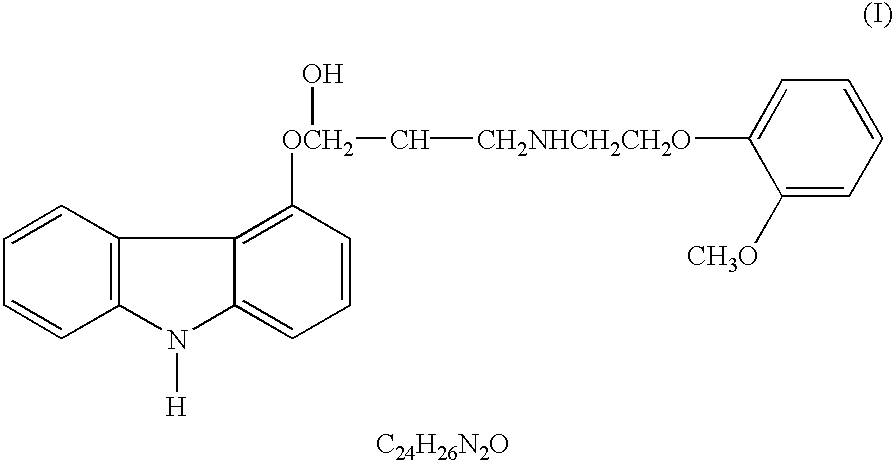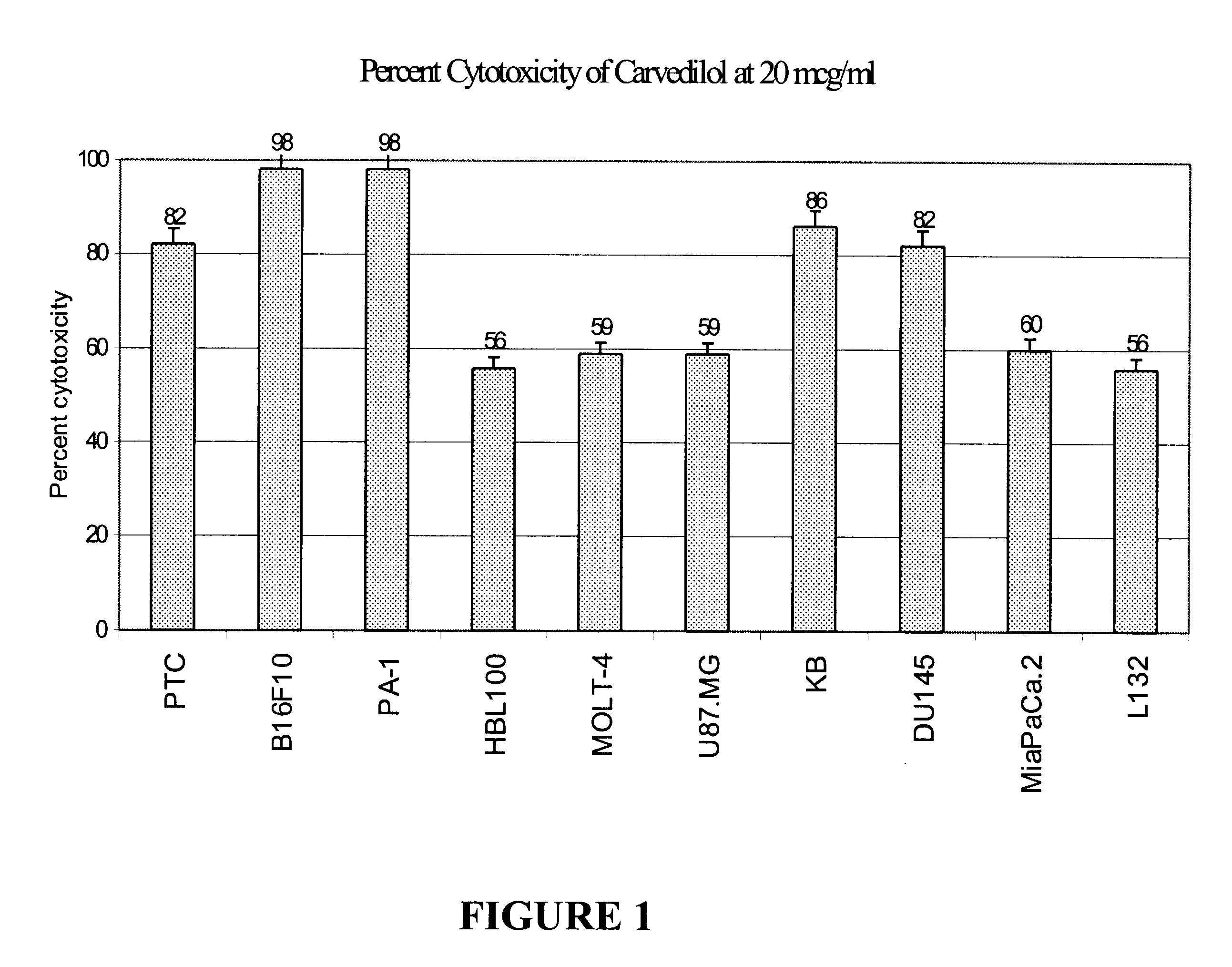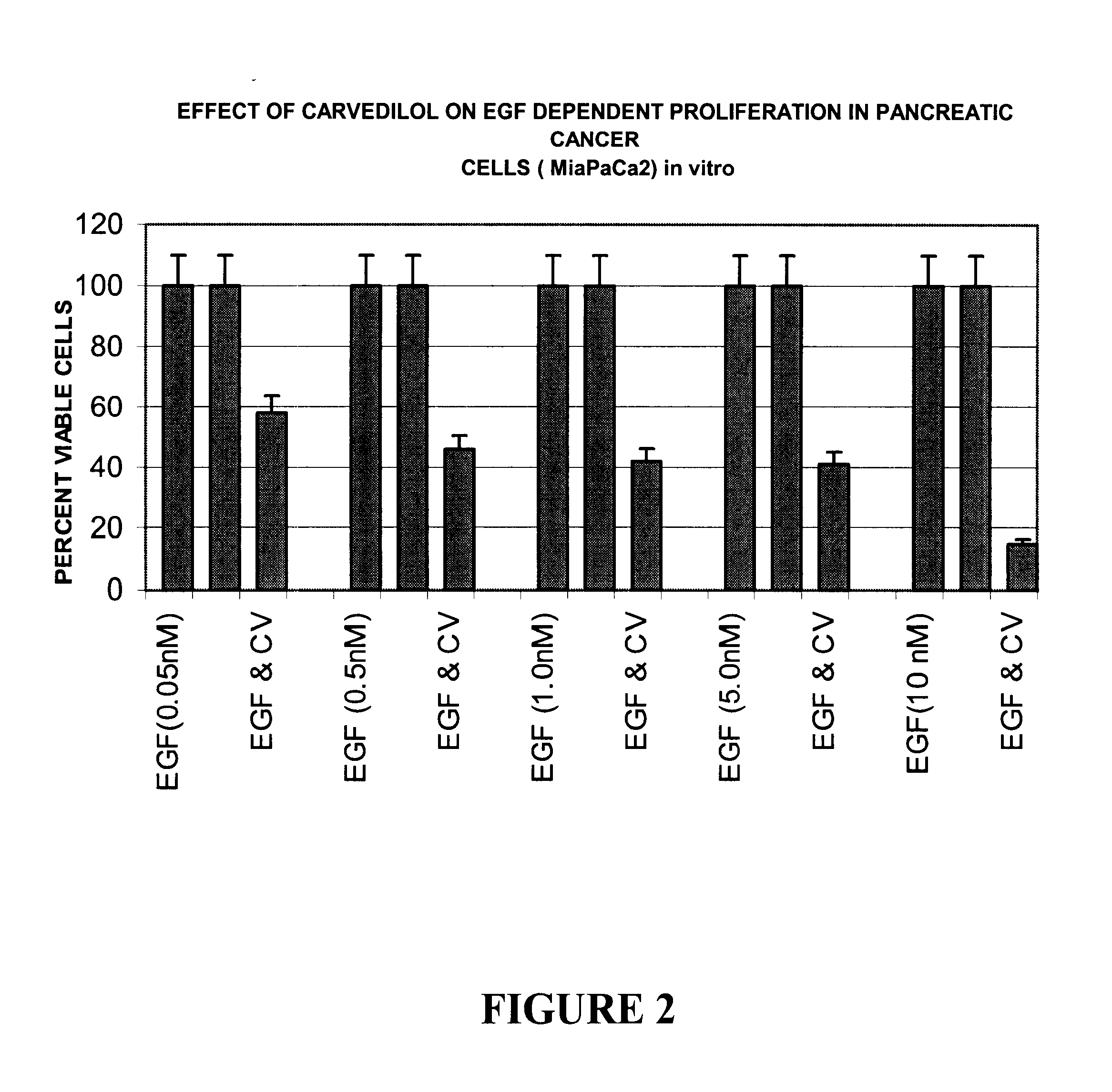Anti-cancer activity of carvedilol and its isomers
- Summary
- Abstract
- Description
- Claims
- Application Information
AI Technical Summary
Benefits of technology
Problems solved by technology
Method used
Image
Examples
example 2
Anti-tumor Activity of the Optically Pure Isomers of Carvedilol
The anti-tumor activity of the optically pure isomers of Carvedilol S(-) and R(+) were evaluated in a 72-hour MTT cytotoxicity assay (Mosmann T., J Immunological Methods, 65:55; 1983) as explained above. Carvedilol and its isomers were evaluated in human tumor cell lines MOLT-4 (leukemia), PTC (colon), KB (oral), L132 (lung) U87MG (glioblastoma), HBL100 (breast), B16F10 (Melanoma), MiaPaCa.2 (Pancreas) and PA-1 (ovary) in a range of concentrations. The ED.sub.50 value (the test concentration which causes 50% cytotoxicity) as calculated graphically was used to compare the relative cytotoxic potential of Carvedilol and its isomers. As shown in Table 2, the active isomers have retained the cytotoxic potential of the parent compound Carvedilol. This shows that the optically pure isomers of Carvedilol are potential anti-cancer agents with the advantage of reduced compounded toxicities associated with the parent compound.
example 3
Effect of Carvedilol on Epidermal Growth Factor (EGF) Dependent Proliferation in vitro
The effect of Carvedilol on Epidermal growth factor (EGF) dependent proliferation was determined by the quantitation of percent viable cells in sera free conditions in vitro. Briefly, 10000 human pancreatic cancer cells (MiaPaCa2) were seeded per well in a 96-well culture plate in DMEM containing 5% FCS. All experiments were carried out in triplicates at 37.degree. C. in a CO.sub.2 incubator. The cells were incubated for a period of 12 hours, washed once with PBS and the medium was changed to DMEM without Fetal calf serum (FCS). Carvedilol was dissolved in 1% DMSO in DMEM. The cells were incubated with Carvedilol at a concentration of 20 ug / l for a period of 16 hours. The untreated control cells were treated with 1% DMSO in DMEM. The cells were washed with PBS and incubated with varying concentrations of EGF in DMEM without FCS for a period of 48 hours. The percent viable cells in absence and prese...
example 4
Effect of Carvedilol on Platelet Derived Growth Factor (PDGF) Dependent Proliferation in vitro
The effect of Carvedilol on Platelet derived growth factor (PDGF) dependent proliferation was determined by the quantitation of percent viable cells in sera free conditions in vitro. Briefly, 10000 human pancreatic cancer cells (MiaPaCa2) were seeded per well in a 96-well culture plate in DMEM containing 5% fetal calf serum (FCS). All experiments were carried out in triplicates at 37.degree. C. in a CO.sub.2 incubator. The cells were incubated for a period of 12 hours, washed once with PBS and the medium was changed to DMEM without FCS. Carvedilol was dissolved in 1% DMSO in DMEM The cells were incubated with Carvedilol at a concentration of 20 ug / ml for a period of 16 hours. The untreated control cells were treated with 1% DMSO in DMEM. The cells were washed with PBS, to remove Carvedilol and incubated with varying concentrations of PDGF in DMEM without FCS for a period of 48 hours. The pe...
PUM
| Property | Measurement | Unit |
|---|---|---|
| Molar density | aaaaa | aaaaa |
| Molar density | aaaaa | aaaaa |
| Molar density | aaaaa | aaaaa |
Abstract
Description
Claims
Application Information
 Login to View More
Login to View More - R&D
- Intellectual Property
- Life Sciences
- Materials
- Tech Scout
- Unparalleled Data Quality
- Higher Quality Content
- 60% Fewer Hallucinations
Browse by: Latest US Patents, China's latest patents, Technical Efficacy Thesaurus, Application Domain, Technology Topic, Popular Technical Reports.
© 2025 PatSnap. All rights reserved.Legal|Privacy policy|Modern Slavery Act Transparency Statement|Sitemap|About US| Contact US: help@patsnap.com



